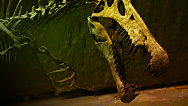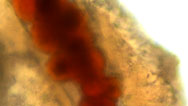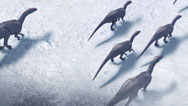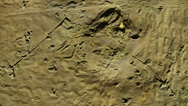Spinosaurus vs. Alligator
- By Ari Daniel
- Posted 10.17.14
- NOVA
Paleontologists now consider Spinosaurus to be the largest carnivorous dinosaur that's ever roamed the Earth. A skeleton offers a glimpse into how this giant reptile lived and moved. But comparing Spinosaurus to one of its living relatives allows scientists to make deeper inferences and bolder renderings of this dinosaur in the flesh.
Transcript
Spinosaurus vs. Alligator
Posted: October 17, 2014
Nizar Ibrahim: I don’t know, do you want to do a direct comparison? Here’s some Spinosaurus teeth. Here’s a big one. I mean, the basic shape is very similar to the big one we see here in Bubba, right?
Paul Sereno: You know, the bizarre thing about Spinosaurus teeth is that they’re so similar to croc teeth—just a single, sharp edge on the front and back. No ornamentation, no bumps, no ridges. Just basically a conical tooth, which is your basic fish-eating tooth. And it’s very similar to the alligator.
The thing that’s strikingly different about this animal—and not all crocodilians, but the alligator in particular—is the flat snout.
Ibrahim: It’s flat and broad.
Sereno: Very different than Spinosaurus.
Ibrahim: If you look at Spinosaurus in front—with an alligator you just have this really wide head you’re looking at. Spinosaurus would just be this long tube almost.
Cristiano Dal Sasso: By using these CT scans, we have a three-dimensional image of the interior of the skull. Here is a concentration of pits, and you see the cross-section of the pits. It indicates a network of sensory terminations.
Ibrahim: For an animal that spends a lot of time in the water going after aquatic prey or prey in the mud, it makes sense to have all of this, you know, very sensitive structure at the tip of the snout.
Sereno: The front part of the tail is really heavy—it occupies about 40% of the weight of the crocodile. It has in it muscle that literally sends the tail into a sinuous curve. Back here, this part is flat, much less muscular—got one single row of scutes. It operates as a paddle. This is a propulsor.
Ibrahim: I see. So the power comes from here, and this is just a paddle, more or less.
Sereno: Propulsor, the paddle. Question is: how much of this was present in Spinosaurus? How much of this swimming tail was present in Spinsosaurus? So was Spinosaurus paddling, and at the same time using this leg muscle to the tail to swim with its tail? I think so.
Credits
PRODUCTION CREDITS
- Produced by
- Ari Daniel
Liz Gillis - Director of Photography
- Stefan Wiesen
- Sound
- Matt Vogel
- Original Footage
- © WGBH Educational Foundation 2014
MEDIA CREDITS
- Music
- The Creeper by Chris Norton and Frank Mizen
- Spinosaurus skeleton
- Flickr/Kabacchi (CC BY 2.0)
- Swimming Spinosaurus
- © Fabio Manucci
IMAGE
- (main image: alligator eye)
- © WGBH Educational Foundation 2014
Related Links
-

Bigger Than T. rex
Meet Spinosaurus—the lost killer of the Cretaceous and the world's largest carnivorous dinosaur ever.
-

T. Rex Blood?
Preserved soft tissue, including possible blood vessels and red blood cells, are turning up in dinosaur fossils.
-

Arctic Dinosaurs
Trek through Alaska to explore how dinosaurs once thrived in polar regions.
-

Experts Debate Dinosaur Stampede
Dinosaur prints in an ancient Australian fossil bed stir a modern debate; were they stampeding, or just out for a swim?

